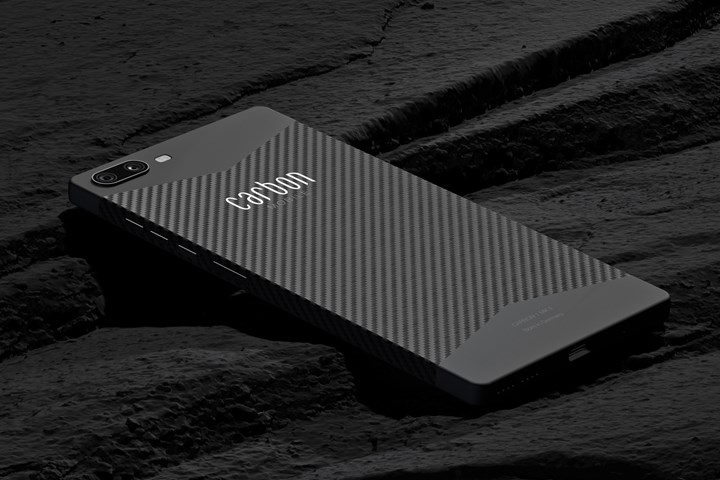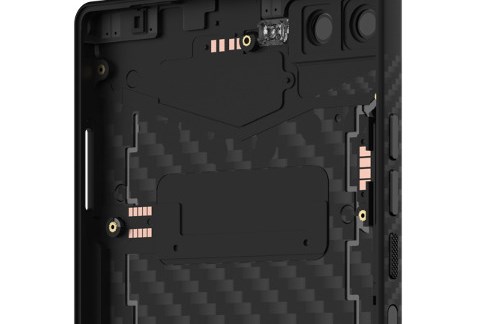‘First’ Carbon Fiber Smartphone Developed by German Startup
Lanxess Tepex dynalite 208 TPU is the matrix material for Carbon Mobile’s ultra-thin and extremely light smartphone.
What is said to be the ‘first’ carbon fiber smartphone that sets new standards for lightness, slim design and sustainability made its debut this March, from Berlin-based startup Carbon Mobile. “Designed and engineered in Germany, the Carbon 1 MK II reignites miniaturization and drives sustainability in connected devices by replacing plastics and aluminum with advanced composite materials for the first time,” says Carbon Mobile’s CEO Firas Khalifeh.
The base material for the production of the housing is a thermoplastic composite from Pittsburgh-based Lanxess’s Tepex dynalite portfolio, specifically Tepex dynalite 208 TPU. It is reinforced with fabrics of incredibly fine 1K continuous carbon fiber filaments. Explained Philipp Genders, Tepex expert in application development at Lanxess. “Our composite material, which we developed for extremely lightweight components subjected to considerable mechanical stress, does more than just allow exceptionally thin wall thicknesses. In fact, with its high degree of strength and rigidity, it also helps to make the housing very robust for day-to-day use,” “In addition, the matte-black carbon-fibers give the smartphone a truly high-tech look.”

Despite their advanced properties for producing robust yet lightweight structures, carbon fibers behave in an electromagnetic shielding manner. This means that they block radio signals, forming a Faraday cage that rather than allowing signals to pass through, instead disperses them around the outer body of the device. Connected devices with carbon fiber, for this reason have been viewed as an impossibility by the tech industry.
After four years of research and development, Carbon Mobile’s engineers have developed a revolutionary process to unlock carbon fiber’s potential for connected devices. The patented HyRecm (Hybrid Radio Enabled Composite Material) technology fuses carbon fibers together with a complementary composite material capable of RF signal permeation. To further boost the devices connectivity, a unique 3D-printed conductive ink is integrated into the carbon fiber structure. The result is the first “radio enabled” carbon fiber based material.
Applied for the first time in the Carbon 1 MK II, the new technology produces a robust carbon fiber-based housing structure that is not only incredibly thin and light, but also made from less than 5% plastic. Said Eric Chan from processing partner Modern Composites Ltd., “Lanxess and their Tepex materials made the perfect partner in the development of HyRecm Technology. Being able to work with a superior material from Germany ensures the best application possible of this revolutionary technology from launch.”

Following the same construction principle as the load-bearing chassis of a Formula 1 car, the housing is designed as a monocoque, or “single shell”. As a result, it makes optimized use of the extreme rigidity of carbon fiber reinforced plastic (CFRP). This contributes significantly to the thin wall thicknesses and low weight of the smartphone and also enables miniaturization. That is because there is no bulky reinforcement taking up space on the inside of the housing. According to Khalifeh, ”Our cutting-edge monocoque design enables a device that weighs only 125 grams, a third lighter than conventional smartphones. At just 6.3 millimeters, it is also 25% thinner as well.”
Working toward a world with less electronic waste, Carbon Mobile is committed to sustainable principles. The new smartphone uses only recyclable materials wherever possible. Said Khalifeh,“We want to deliver our contribution to cutting electronic waste and improving sustainability around the world,” says Khalifeh. The composite material used for the housing can also easily be recycled and repurposed for new uses. Added Genders, “Like all products in the Tepex dynalite product line, it can be shredded and then processed on standard injection-molding machines to make high-quality components, either by itself or mixed with suitable new material.” To extend the service life of the smartphone, all its components are designed to be easily replaceable for repair purpose, which also prevents the creation of electronic waste.

Related Content
The Importance of Melt & Mold Temperature
Molders should realize how significantly process conditions can influence the final properties of the part.
Read MoreThe Effects of Temperature
The polymers we work with follow the same principles as the body: the hotter the environment becomes, the less performance we can expect.
Read MoreUnderstanding the ‘Science’ of Color
And as with all sciences, there are fundamentals that must be considered to do color right. Here’s a helpful start.
Read MoreNew Entrant Heartland Polymers Stepping up as Reliable Supplier
Heartland Polymers’ new Alberta, Canada facility will produce 525 KTA propylene and 525 KTA polypropylene. It is expected to stabilize supply chains across the continent.
Read MoreRead Next
Why (and What) You Need to Dry
Other than polyolefins, almost every other polymer exhibits some level of polarity and therefore can absorb a certain amount of moisture from the atmosphere. Here’s a look at some of these materials, and what needs to be done to dry them.
Read MorePeople 4.0 – How to Get Buy-In from Your Staff for Industry 4.0 Systems
Implementing a production monitoring system as the foundation of a ‘smart factory’ is about integrating people with new technology as much as it is about integrating machines and computers. Here are tips from a company that has gone through the process.
Read MoreUnderstanding Melting in Single-Screw Extruders
You can better visualize the melting process by “flipping” the observation point so that the barrel appears to be turning clockwise around a stationary screw.
Read More


























